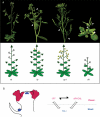Floral initiation and inflorescence architecture: a comparative view
- PMID: 17679690
- PMCID: PMC2533596
- DOI: 10.1093/aob/mcm146
Floral initiation and inflorescence architecture: a comparative view
Erratum in
- Ann Bot (Lond). 2007 Dec;100(7):1609
Abstract
Background: A huge variety of plant forms can be found in nature. This is particularly noticeable for inflorescences, the region of the plant that contains the flowers. The architecture of the inflorescence depends on its branching pattern and on the relative position where flowers are formed. In model species such as Arabidopsis thaliana or Antirrhinum majus the key genes that regulate the initiation of flowers have been studied in detail and much is known about how they work. Studies being carried out in other species of higher plants indicate that the homologues of these genes are also key regulators of the development of their reproductive structures. Further, changes in these gene expression patterns and/or function play a crucial role in the generation of different plant architectures.
Scope: In this review we aim to present a summarized view on what is known about floral initiation genes in different plants, particularly dicotyledonous species, and aim to emphasize their contribution to plant architecture.
Figures




References
-
- Abe M, Kobayashi Y, Yamamoto S, Daimon Y, Yamaguchi A, Ikeda Y, et al. FD, a bZIP protein mediating signals from the floral pathway integrator FT at the shoot apex. Science. 2005;309:1052–1056. - PubMed
-
- Ahearn KP, Johnson HA, Weigel D, Wagner DR. NFL1, a Nicotiana tabacum LEAFY-like gene, controls meristem initiation and floral structure. Plant Cell Physiology. 2001;42:1130–1139. - PubMed
-
- Alvarez J, Guli CL, Yu X-H, Smyth DR. TERMINAL FLOWER: a gene affecting inflorescence development in Arabidopsis thaliana. Plant Journal. 1992;2:103–116.
Publication types
MeSH terms
LinkOut - more resources
Full Text Sources
Other Literature Sources

